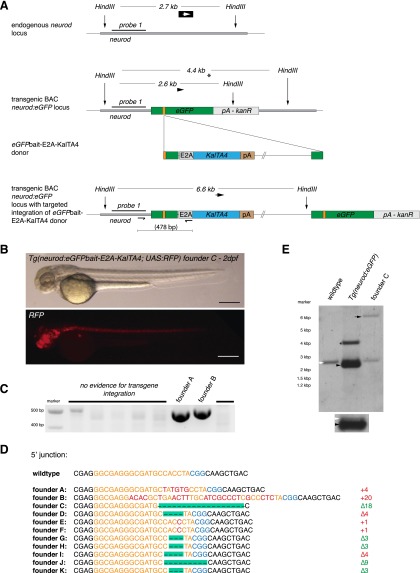Figure 5.
Analysis of stable germline transmission of the Tg(neurod:eGFPbait-E2A-KalTA4) transgene. (A) Schematic depicting the Southern blot design to detect KalTA4 transgene integration. The neurod locus-specific probe 1 detects a 2.7-kb fragment after HindIII digest in the wild-type allele. The transgenic BAC neurod:eGFP locus is digested into a 2.6-kb fragment and, in the case of a partial digest in the BAC backbone, into a 4.4-kb fragment. After insertion of the KalTA4 cassette, a 6.6-kb fragment is detected. (B) Brightfield and fluorescent images of a transgenic Tg(neurod:eGFPbait-E2A-KalTA4) embryo at 2 dpf. (C) Screening for transgene integration by PCR in eight potential founders. Two show the expected fragment size (478 bp) (cf. Fig. 1A for primer positions and amplicon size). Note that the amplicon of founder B is slightly larger, as confirmed by sequencing and shown in D. (D) Sequences of 5′ junction sites of alleles identified in stable transgenic founders. Out of 11 founders showing stable transgene integration and transmission, five had an in-frame integration of the transgene. (Orange) sgRNA binding site; (blue) PAM sequence NGG; (red) integrated additional base pairs. (E) Analysis of the stable founder C for site-specific transgene integration by Southern blot analysis. As controls, wild-type and Tg(neurod:eGFP) embryos were used. Compare the schematic shown in A for expected fragment sizes. The 2.7-kb wild-type neurod fragment can be seen in all three samples (white arrow). The Tg(neurod:eGFP) sample shows a further fragment at 2.6 kb with greater intensity (black arrow) consistent with multiple insertions of the BAC construct. A shorter exposure is shown below to better distinguish the two separate bands. A further fragment at 4.4 kb is visible (asterisk), probably arising from incomplete digest of the neurod:GFP BAC trangene. In founder C, the neurod:eGFP band is no longer visible—instead, a fragment at 6.6 kb corresponding to the integration of KalTA4 into the eGFP sequence is detected.

